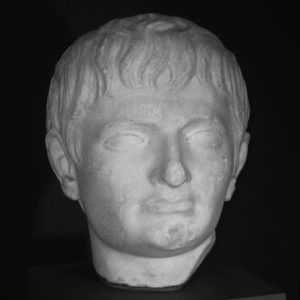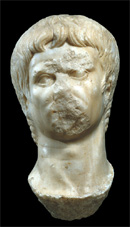Portrait heads of the emperor Octavius Augustus.

“The Joslyn portrait displays clear indications that it was recut from another person’s likeness, limiting the sculptor by dissimilarities to Augustus’ features in the original subject. Recut portraits in general exhibit asymmetries, undercutting, and unnatural planar features where a chisel or other implement has been used to remove undesirable elements. Here, for example, a shallow trough on the forehead is a result of cutting back longer locks in the original. Great care was taken to emulate Augustus’ signature fork-and-pincer feature higher up on the forehead, using the technique of undercutting to create the illusion of volume and definition, which in the process created the trough. […] Careful examination of the nape of the neck further reveals the work of the chisel in removing excess hair. […]
The surviving locks, as well as the shape of the face, the left turn of the head, and the amount of hair removed at the nape of the neck, strongly suggest that the original portrait was a replica of the so-called “Cagliari type” of the emperor Nero (r. 54–68 A.D.). This first official portrait type of Nero as emperor was created early in his reign, around 54–59 A.D., and featured a caplike hairstyle, with long strands centrally parted low on the forehead; long, wide sideburns; and a longish hair treatment at the nape of the neck.”
https://www.joslyn.org/collections-and-exhibitions/permanent-collections/ancient/roman-head-of-augustus/

“The neck’s base is roundish, detail indicating that the head, sculpted separately, was designed to a monumental sculpture, whether a full-length one or to be implanted on a pedestal, which worked as a support to high-ranking figures’ removable heads, being thus easily replaced when necessary. For a long time, it stood on a togaed statue, to which it did not belong. It comes from Myrtilis, where it would stand in the first place, certainly at the city Forum.
The item shows different proportions between the long face and the thick hair, as well as the broad neck, leading to the hypothesis that the emperor portrayed in the first place might have been Caligula, whose damnatio memoriae (damnation of memory) should have provoked the opportune remaking of the item according to his predecessor’s iconographic rules of proportion. (According to record of the MNA’s Roman Sculpture Catalogue, by José Luís de Matos).”
http://www.museuarqueologia.pt/?a=3&x=2&i=154